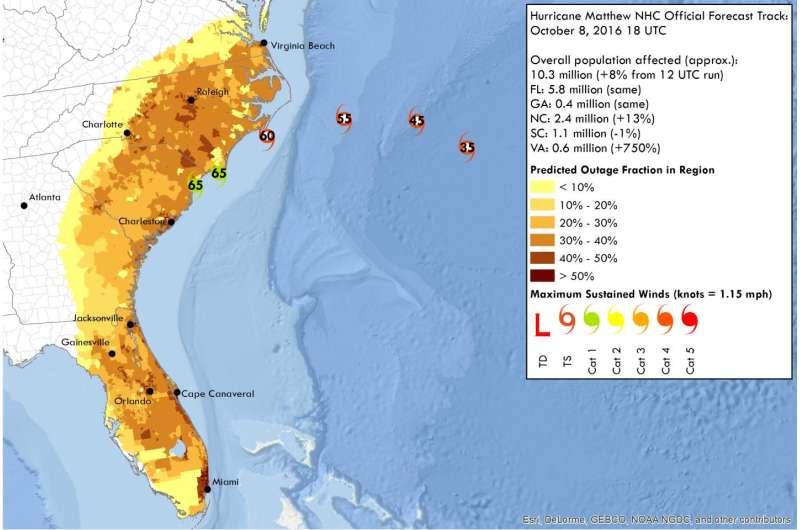How soil moisture can help predict power outages caused by hurricanes

In the days before Hurricane Matthew, researchers used satellite maps of soil moisture to help forecast where the power would go out along the East Coast.
At the American Geophysical Union meeting this week, they report that their method worked with 91 percent accuracy.
The project aims to curtail outages by helping power companies allocate equipment and crews in advance of storms, said Steven Quiring, professor of atmospheric sciences at The Ohio State University.
Healthy trees that receive just the right amount of moisture are less prone to storm damage, he explained, so soil moisture is a good indicator of where outage crews will be needed.
"We see increased numbers of outages at both ends of the spectrum—wherever soils are too wet or too dry," Quiring said. "Drought makes tree branches more likely to snap off, and over-saturation makes trees more likely to be uprooted."
He cited a 2012 report from the Congressional Research Service that named severe weather as the single biggest cause of outages in the United States. More specifically, severe weather damage to vegetation is the biggest cause. Around 62 percent of the time, the report concluded, the power goes out because broken tree branches or falling trunks contact power lines.
For Hurricane Matthew, the researchers were able to forecast five days ahead of time that 4.5 million people would be without power in Georgia, North Carolina, South Carolina and Virginia. The actual number worked out to be around 4.1 million, so the researchers overestimated the extent of outages by around 9 percent.
NASA's Soil Moisture Active Passive (SMAP) satellite mission provided the data, which the researchers cross-referenced with population density, land use, average wind speed and the duration and intensity of storms to make their forecast model.
The team, which includes Seth Guikema at the University of Michigan and Brent McRoberts at Texas A&M, has been using a similar computer model—minus the NASA SMAP soil moisture measurements—to predict hurricane-caused power outages for about a decade. For instance, they correctly estimated that superstorm Sandy would knock out power for about 10 million people in 2012.
Quiring said the researchers are expanding the project to include outages caused by thunderstorms, winter storms and wind storms, which impact a much larger portion of the United States than hurricanes. They are already working with several power companies along the East Coast, and hope to form partnerships with companies in the Midwest and South next.
Outages cost the American economy as much as $33 billion annually, according to the President's Council of Economic Advisers and the U.S. Department of Energy (DOE) Office of Electricity Delivery and Energy Reliability.
Provided by The Ohio State University



















